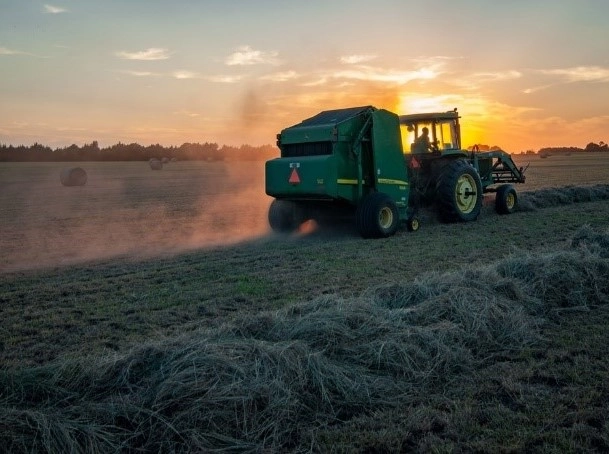Four key steps to minimising fire risks related to industrial vehicles
Businesses operating within high-risk industries, such as manufacturing, mining or agriculture, utilise industrial vehicles on a daily basis. Forklifts, self-propelled vehicles and tractors are all examples of vehicles which are key in the day-to-day operations of these industries, with little room for any period of downtime. However, there are a number of fire risks associated with the use of industrial vehicles. As such, it’s important for all potential risks to be addressed, to allow measures to be taken to avoid potential fire hazards and ensure safety at the site.


Risks associated with the use of industrial vehicles
-
Electrical failures
The global shift towards electric vehicles and hybrid electric vehicles (EVs and HEVs) has meant that many industries have ‘electrified’ their fleets. These vehicles bring new safety risks, notably the potential for thermal runaway. Thermal runaway is a chemical reaction, which occurs as the result of a failure in the vehicle’s battery. This can cause a rapid increase in temperature. In thermal runaway, the propagation process will quickly become self-sustained, as the battery begins to produce its own oxygen. This can further propel fire and cause significant damage to vehicles and their surroundings. Thermal runaway can be the result of short-circuiting, overcharging and or overheating.
Additionally, other industrial vehicles often include various electrical components, meaning they face similar fire risks.
-
High-risk environments
Industrial vehicles often operate in demanding, high-risk environments, such as near hot works, with flammable materials or near to storage areas. In these environments, there are a number of factors which could pose key fire risks.
For example, in environments working with hot works, vehicles are exposed to a number of ignition sources. Sparks can be given off from welding, soldering or grinding, which have the potential to ignite surrounding combustible materials. This can cause significant damage to assets and vehicles if not monitored carefully.
-
Infrequent cleaning or maintenance
It is common for industrial vehicles to become clogged as a result of dust build-up. In addition, a lack of maintenance can result in faults going unnoticed for longer periods of time. If not monitored, these faults can pose significant fire risks.
Fuel spills, from vehicles themselves or as a result of flammable liquids being transported around a site, can also present significant fire risks. If these spills are not attended to, they can further inhibit the performance of industrial vehicles and cause increased fire risks, compromising the safety of teams and assets in the process.
-
Arson
Arson is often overlooked when identifying fire safety risks, but despite it being less common, it’s still a significant cause of vehicle fires across the UK. Vacant or unsecured vehicles are at an increased risk of arson, as these will often be targeted by criminals.


Reducing the risks and ensuring site safety
Here are some practical steps you can take to safeguard your workforce, assets and buildings:
-
Selecting the right fire protection and suppression solution
Your vehicle’s fire protection and suppression solution should be tailored specifically to its individual risks and uses:
- EVs or HEVs – EVs or HEVs suppression solutions should be specifically designed to prevent the vehicle from entering thermal runaway. Where this is not possible, the solution should delay the progression to thermal runaway, as this will allow passengers to evacuate safely and notify others of the fault.
- Monitor the risks – vehicles should be subject to regular risk assessments, to identify potential risks. This will allow you to introduce the most effective fire suppression solution to maximise fire safety.
-
Regularly monitor the vehicle’s surroundings
The environment your vehicle operates within is highly influential in the effectiveness of your fire suppression solutions. As such, regularly monitoring the environment can help to mitigate fire risks:
- High-risk environments – vehicles should be kept away from high-risk works.
- Materials storage – monitoring storage surrounding a vehicle is important to reducing fire risk. For example, flammable materials or liquids should not be within close proximity to vehicles.
- Risk assessments – risk assessments are fundamental to highlighting current or potential risks and providing solutions on how to counteract them.
-
Staying up to date with regular vehicle and site cleaning and maintenance
Cleaning and maintenance of vehicles is integral to identifying any issues early, avoiding the possibility of small issues causing greater fire risks.
- Temperature monitoring – this will reduce the risk of overheating.
- Vehicle charging – any vehicle charging should be completed away from any operations, as power supplies can give off sparks, which have the potential to ignite surrounding flammable material.
- Site cleanliness – it’s important to ensure that when fuel and flammable liquids are spilt, they are cleaned immediately.
-
Implement key security measures
Despite arson being a less common risk, implementing appropriate security measures is still important to reduce its risk:
- Secure your premises – whenever the site is left unattended, it’s important to make sure that the facilities are locked and therefore inaccessible to criminals. All external materials which are situated near the perimeter of the site should be moved away, and valuables should be securely locked away inside the site.
- Store flammable materials away – flammable materials should be secured in a safe area, to prevent the access to them for any intruders.
- Restrict area access – when storage facilities are not in use, they should be secured. Access to the facilities should also be closely monitored.
- Encourage team reporting – it’s important that your team are aware that they should report any suspicious activity on site, which could potentially have safety implications.
Minimal downtime, maximum safety
Industrial vehicles should be managed and monitored carefully, as they are a great asset for high-risk industries.
For more information on how you can safeguard your assets and people with your vehicle’s fire suppression solution, get in touch.
Image sources:

